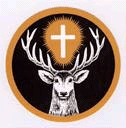
Eustace Families Association

Ballymore Eustace
In Ireland on the border between the counties of Kildare andWicklow is the town of Ballymore Eustace-thegreat town of the Eustaces. In the Gaelic language it iswritten Baile mor na n-Iustasach. This quiet villagecommemorates a branch of The family whose colorful history isfilled with the greatest extremes of triumph and tragedy. Historyrecords the first Eustace in the district about the year 1330 atCastlemartin in the Parish of Kilcullen.
In medieval times the Archbishop's Castle of Ballymore was oneof the chief defenses of the Pale against the dispossessed Irish.For five generations early branches of the Eustace family heldthe castle at Ballymore. In 1373, Thomas, son of OliverFitz-Eustace, was appointed by the Archbishop to the position ofconstable of the Castle of Ballymore, with a salary of 10 Poundsper annum, provided he resided there with his family. This Thomaswas almost certainly a brother of Roland FitzOliver who ownedCastlemartin, another well -known Eustace estate. He marri edMatiIda, widow of William FitzWalter of St. Albins, butapparently left no heir as his line was carried on by Sir MauriceFitzEustace, presumably a third brother. In 1355, GeoffreyFitzEustace and Richard de Penkestown, Sheriffs of Kildare, weredirected to see that the garrisons of Kilteel, Rathmore,Ballymore, and Graney were up to their full strength so as toresist the incursions of the O'Tooles, O'Byrnes, and theMacMurroughes. Sir Mauri ce Eustace of Ballycotelan was HighSheriff of Kildare i n 1377, 1384, and 1386, and of Dublin in1386 and 1389. Si r Richard Eustace, son of Sir Maurice wasconstable of Ballymore Eustace and High Sheriff of KiIdare in1414 and was a member of Parliament. In 1426, he was appointedLord Chancellor and was Deputy Chancellor for ten years. He diedin 1445. In 1468, the Parliament held at Drogheda, enacted thatthe office of castelIan was not to be entrusted to an Irishman.It had become hereditary in the Eustace family, and it appearedthat Robert FitzEustace, son of Sir Richard, did not keep hisresidence there, but had appointed a sub-constable named LawrenceO'Rogan, an Irishman by both father and mother, who by naturewould disclose the secrets of the English. Accordingly it wasenacted "that said Robert FitzEustace be compelled to keep asufficient company Englishmen, and no Irishman. Not having hischarter of liberty, to ward the said castle, then it shall belawful for the Archbishop and his successors to turn RobertFitzEustace out of the constableship, and give the office toanyone for life or years. Sir Robert regained his post and servedas High Sheriff of Kildare in 1452,1456 and 1470. In 1471, he wasappointed constable of Kings Castle in Wicklow. Sir Robert diedin 1486 and was succeeded as constable by his son, Sir MauriceEustace who was High Sheriff in 1499. About 1501, Sir Mauricemarried Joan Eustace, widow of the 2nd Baron of Dunsony anddaughter of Sir Rowland Eustace, Lord Portlester. He died in 1520leaving as his heir Christopher Eustace, born about 1502.Christopher Eustace joined his neighbors and kinsmen, theFitzGeralds in the Silken Thomas RebelIion, was captured andhanged in 1537, his estates being forfeited. Nicholas Eustace,Christopher's nephew, succeeded Sir Maurice as constable andduring his tenure Ballymore Eustace was plundered by theGeraldines and the Eustaces become entangled in one of thesaddest periods of Irish history. Nicholas Eustace died in 1577and the direct line became extinct but members of the familycontinued to live in the neighborhood and are frequently referredto in the records.
Today the Eustaces are gone from Ballymore Eustace, yet as alasting memorial the local citizens still stubbornly cling to theold name of their town and sternly refuse to omit the suffixEustace. Two massive crosses standing in The Anglican churchyardand another by a wayside a mile and a half west of the towncommemorate past members of The Eustace family, but their exactorigin remains unknown. Inside the Anglican church of BallymoreEustace lies a mediaeval effigy of a knight which around 1858 wasremoved f rom KiIcullen to Barretstown Castle by Sir ErasmusBorrowes to preserve it from further damage as it had once beenused as a fIagstone under a pump. Experts date this effigy to theearly 16th century and have concluded that it represents a memberof the FitzEustace family.